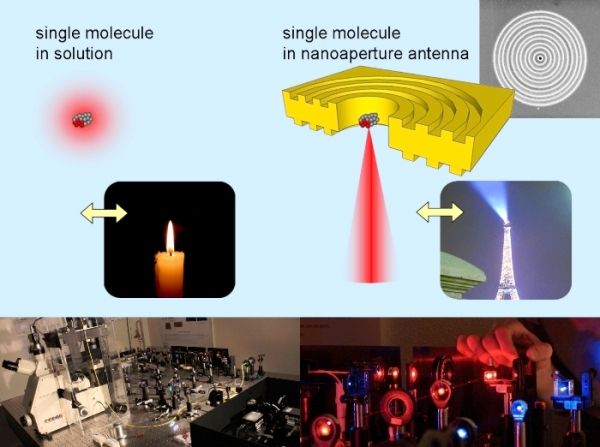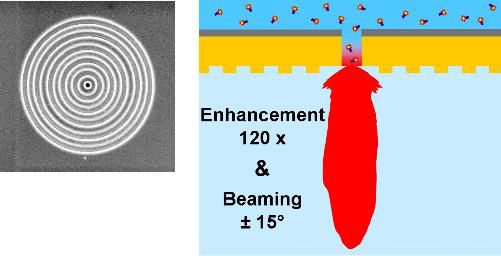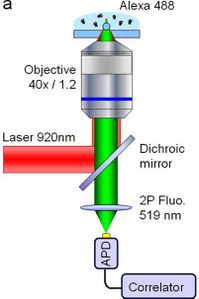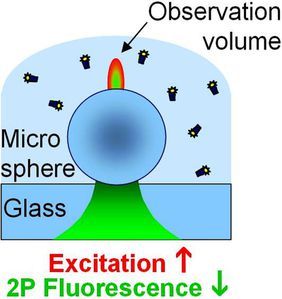recent research work
Research highlighted by CNRS
Our latest research published in a Nano Letters article has been selected by the CNRS in the "highlighted news" section. Here is an English version:
Molecular Nano-Headlight: turning a single molecule into a bright source of light
Looking for single molecules under the microscope. Many physical and chemical methods aim at analyzing single molecule behaviors. However, single molecule detection is a challenging task, due to the very weak amount of light that is radiated by a single molecule.
Nano-Antennas to control the emission of light. To increase and control the light emitted by a single molecule, scientists from the Fresnel Institute and the Institute of Supramolecular Science and Engineering ISIS use metal antennas of nanometer dimensions. These antennas are designed to work for light as conventional antennas work for radio waves. Both the emission intensity and direction can be controled down at the single molecule level, which realizes a major breakthrough.
The researchers use a special kind of nanoantenna made of an aperture surrounded by circular corrugations milled in a gold film. This antenna transforms a standard molecule into a bright unidirectional fluorescence source: the fluorescence intensity is enhanced up to 120 fold, and almost all the light is emitted into a narrow cone in the vertical direction.
The bright emission and narrow directionality enable the detection of single molecules with a simple microscope, and improve the effectiveness of fluorescence-based applications. This demonstration is of high relevance for the development of biochemical sensing methods, light emitting devices, and quantum information processing.

Nano Letters paper published online
Our study on fluorescence enhancement and beaming in nanoapertures with circular corrugations has just been released on the Nano Letters website. See the abstract here. A free reprint (for personal use only) can be downloaded here.
Rationale: A wide range of applications in physical and chemical sciences is presently limited by the weak optical signal emitted by a single fluorescent molecule. To overcome this challenge, plasmonic antennas are receiving a growing interest to control both the fluorescence rate and angular emission distribution from single quantum emitters. However, there is currently no experimental demonstration reporting a clear improvement in both the emission intensity and directionality using the same nanoantenna. We solve this issue here.
Results: we report the demonstration of bright unidirectional photon sources from single molecules. The emission rate per molecule is enhanced up to 120 fold, and simultaneously the fluorescence emission is directed into a narrow angular cone of 15°. This work has four major aspects of general interest:
1) Each of our results on enhancing the fluorescence signal and narrowing the angular distribution is going well beyond the current state-of-the-art, and moreover, we achieve both features simultaneously on the same structure, which is unique to our knowledge.
2) Nanoapertures surrounded by periodic corrugations have generated a considerable interest in the photonics community. This is the first study where corrugated apertures are used to enhance the detection of single molecules.
3) We thoroughly quantify the increased light-matter coupling and the radiation pattern at the single emitter level.
4) The bright emission and narrow directionality release the need for high-end microscope objectives. Efficient detection of single molecules is achieved with a simple low numerical aperture objective.

Scientific achievements 2007-2010
On January 05-06th, the entire Fresnel Institute will be evaluated regarding its activities during the 2007-2010 period. The final slide of my presentation for this evaluation will summarize the main achievements (see the links to read more):
2007: live cell membrane investigations with nanoapertures
2008: complete fluorescence characterization in nanoapertures & microsphere-enhanced fluorescence
2009: 100x speed increase in FCS measurements & crucial role of the gold adhesion layer in plasmonics
2010: smallest single molecule fluorescence endoscope & quantum dots to probe nanoantennas
As I will go through several evaluation processes in 2011 (for fundings, CNRS progress...), I hope this type of slide may also help.

Latest article: enhanced second harmonic generation on nanoapertures
My team has recently published a study on second harmonic generation on single gold nanoapertures. This was released in the December 1st issue of Optics Letters. You can find a free reprint here.
Metal nanostructures are interesting emitters for second harmonic generation (SHG) radiation, which occurs essentially from the non-centrosymmetry breaking at the metal-medium interface for objects of the order of 50nm-100nm size.
At MOSAIC we demonstrate the ability of single-subwavelength-size nanoapertures fabricated in a gold metal thin film to enhance second-harmonic generation (SHG) as compared to a bare metal film. Nonlinear microscopy imaging with polarization resolution is used to quantify the SHG enhancement in circular and triangular nanoaperture shapes.
This study has two main results:
* The SHG enhancement on circular nanoapertures is demonstrated to originate from both phase retardation effects and field enhancements at the aperture edge.
* Triangular nanoapertures exhibit superior SHG enhancement compared with circular ones, as expected from their noncentrosymmetric shape.


Latest article: enhanced two-photon excitation of fluorescence
Two-photon excitation of single fluorescent molecules has generated much interest and expectations, especially for analytical sciences. However, current demonstrations struggle with low two-photon fluorescence rate per molecule and/or high background. In a recent publication in Biomedical Optics Express, we answer these challenges by using a single polystyrene microsphere under focused Gaussian illumination. This opens new opportunities to extend the applications of two-photon fluorescence detection.
1- We demonstrate a simple, robust, and low-cost solution to enhance the two-photon fluorescence signal per molecule up to one order of magnitude, without adding any significant photoluminescence noise. This goes significantly beyond the current state-of-the-art.
2- We perform a thorough characterization of the two-photon fluorescence enhancement in the vicinity of a single dielectric microsphere, and report 30x higher fluorescence enhancement factors than earlier work in the field.
3- The microspheres form an interesting structure to compare the gains in one- and two-photon excitation of fluorescence. Such comparison has been seldom reported in the litterature.





